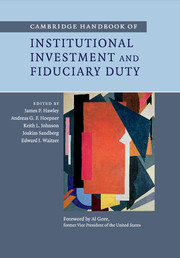Book contents
- Frontmatter
- Contents
- List of figures
- List of tables
- List of contributors
- Foreword
- 1 Introduction
- Part I Fiduciary duty: a global outlook
- Part II Fiduciary duty and the landscape of institutional investment
- Part III Challenging conventional wisdom on fiduciary duty
- Part IV Towards a broader interpretation of fiduciary duty
- Part V Beneficiaries’ roles and viewpoints
- Part VI Fiduciary duty and governance
- 30 Investors and global governance frameworks: broadening the multi-stakeholder paradigm
- 31 Promoting corporate sustainability through integrated reporting: the role of investment fiduciaries and the responsibilities of the corporate board
- 32 Reporting and standards: tools for stewardship
- 33 US corporate governance, fiduciary success and stable economic growth
- 34 Fulfilling fiduciary duties in an imperfect world – governance recommendations from the Stanford Institutional Investor Forum
- 35 Addressing the participation gap in institutional investment: an assessment framework and preliminary results
- 36 The costs of fiduciary failure – and an agenda for remedy
- Index
- References
36 - The costs of fiduciary failure – and an agenda for remedy
Published online by Cambridge University Press: 05 April 2014
- Frontmatter
- Contents
- List of figures
- List of tables
- List of contributors
- Foreword
- 1 Introduction
- Part I Fiduciary duty: a global outlook
- Part II Fiduciary duty and the landscape of institutional investment
- Part III Challenging conventional wisdom on fiduciary duty
- Part IV Towards a broader interpretation of fiduciary duty
- Part V Beneficiaries’ roles and viewpoints
- Part VI Fiduciary duty and governance
- 30 Investors and global governance frameworks: broadening the multi-stakeholder paradigm
- 31 Promoting corporate sustainability through integrated reporting: the role of investment fiduciaries and the responsibilities of the corporate board
- 32 Reporting and standards: tools for stewardship
- 33 US corporate governance, fiduciary success and stable economic growth
- 34 Fulfilling fiduciary duties in an imperfect world – governance recommendations from the Stanford Institutional Investor Forum
- 35 Addressing the participation gap in institutional investment: an assessment framework and preliminary results
- 36 The costs of fiduciary failure – and an agenda for remedy
- Index
- References
Summary
Introduction
Institutional investors occupy the fulcrum of two vital dimensions of modern capital markets: the value of public corporations they own, and the financial security of the citizen-savers they serve. Yet for as much effort as policymakers around the world have spent modernizing corporate structures, they have devoted comparatively little attention to institutional investors.
Consequences for companies are profound. Regulators count on institutional investors to help police the market against the risk of repeat systemic crises and fraud, CEOs pay for failure and anemic value creation. In fact, a host of archaic barriers prevent all but a handful of funds from meeting the high expectations placed on them as owners of public corporations. Some observers even contend that the consequence of decades of governance reinvention must now be seen as deeply harmful. Yes, these critics assert, reform succeeded in making corporate boards responsive – but to funds that are habitual short-term traders, not long-term capital stewards. If that is true, policy has unwittingly put company directors and CEOs under more pressure than ever to pursue speedy profit over long-term value and social responsibility. “Corporations continue to place a strong emphasis on quarterly returns, because investors do,” notes governance thought leader Ira M. Millstein. As one key report concluded, “The obsession with short-term results by investors, asset management firms, and corporate managers collectively leads to the unintended consequences of destroying long-term value, decreasing market efficiency, reducing investment returns, and impeding efforts to strengthen corporate governance” (CFA 2006). Similar charges are common in Europe, where the highly contentious – and ultimately catastrophic – Royal Bank of Scotland-led consortium takeover of ABN-Amro in 2007 prompted widespread calls to curb alleged investor short-termism (see also Keay 2011).
- Type
- Chapter
- Information
- Publisher: Cambridge University PressPrint publication year: 2014



